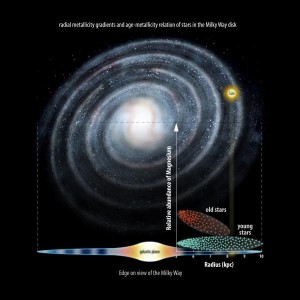The Milky Way Galaxy may have formed from the inside-out, according to data from the Gaia-ESO Survey.
Using data gathered by the ESO’s 8-meter Very Large Telescope (VLT), located in Chile’s Atacama desert, astronomers were able to make their findings by tracking and studying the amounts of elements, such as magnesium, within the chemical composition of stars and gases contained within the galaxy.
The astronomers made detailed observations of a number of different-aged stars, located in a variety of regions of the Milk Way to accurately determine their metallicity, which is the amount of chemical elements contained within a star other than the two basic chemicals—hydrogen and helium—that stars are made of.
Shortly after the Big Bang about 14 billion years ago, the universe was made up only of those two basic elements (H & He), but over time, the cosmic mix included more and more metallic contaminants. As a result, the older stars have fewer of these contaminants, or less metallicity, while newer stars have more of these elements in their mix.
“The different chemical elements of which stars—and we—are made, are created at different rates,” said Gerry Gilmore, lead investigator on the Gaia-ESO Project.”Some in massive stars which live fast and die young, and others in sun-like stars with more sedate multi-billion-year lifetimes.”
Astronomers refer to stars with a mass of at least eight times that of the sun as massive stars. These massive stars tend to have relatively short lives which end in core-collapse supernovae.
This type of event is triggered when the nuclear fusion processes of the star (how a star produces energy) suddenly causes its core to collapse against its own gravity, which can cause it to explode and die.
This core-collapse supernova event can form a neutron star, a black hole, or even kick-start the formation of new stars.
The astronomers said that as the massive stars die, they produce large amounts of magnesium.
The team said older stars that do exist inside the Solar Circle—the orbit our sun makes around the center of the Milky Way—usually have higher levels of magnesium, which suggests that part of our galaxy contained more stars with a relatively shorter life span.
Stars outside of the Solar Circle, located within the outer regions of the galaxy, are younger and tend to have very low levels of magnesium.
The research team said its discovery illustrates the differences in the evolution of stars in our galaxy. The stars that took less time to form are closer to the core of the Milky Way, while the stars with a much longer, more involved formation process, reside closer to the edge of the galactic disk of the Milky Way.
“We have been able to shed new light on the timescale of chemical enrichment across the Milky Way disc, showing that outer regions of the disc take a much longer time to form,” said Maria Bergemann from Cambridge’s Institute of Astronomy, who led the study. “This supports theoretical models for the formation of disc galaxies in the context of Cold Dark Matter cosmology, which predict that galaxy discs grow inside-out.”
The astronomical team’s findings were recently published online in the astronomical database ‘Astro-ph’, and have also been submitted to the journal Astronomy and Astrophysics for possible publication.
























The heavens declare His glory. Before Einstein, before the milky way, and oh my! Long before the beginning………..” I am”.